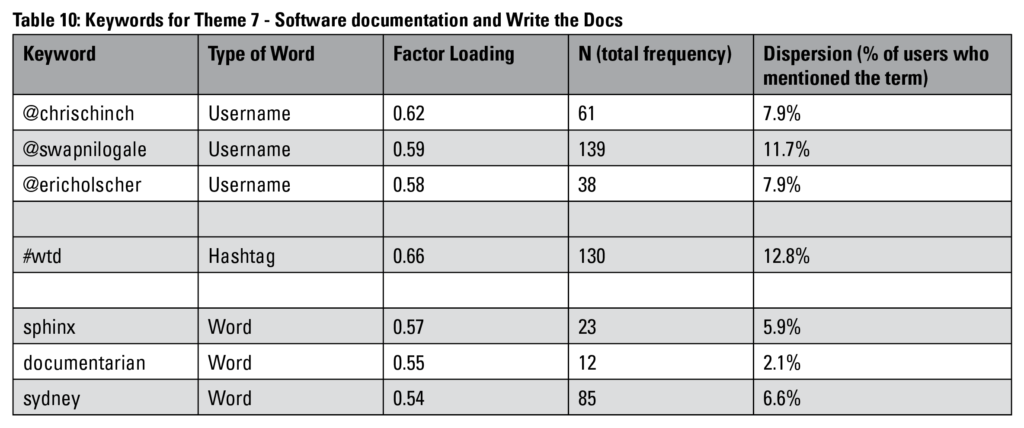By Chris Lam
ABSTRACT
Purpose: This study provides a four-year overview of the #TechComm community on Twitter, specifically identifying influential members, key networks, and thematic content of tweets. This data provides insight into trends, tools, organizations, and events prevalent in the #TechComm community.
Method: The study reports outcomes of four methods. First, statistical analyses were used to analyze 75,333 tweets from the most active 290 members of the #TechComm community. Second, profile data from community members’ profiles were coded per mutually exclusive categories. Third, the TAGS Explorer, which uses Google’s visualization API, was used to explore networks and sub-networks. Finally, a principal components analysis was conducted to examine topics and to identify significant themes in the tweets.
Results: Members of the #TechComm community are diverse, with a majority being practitioners. Most members self-identify as technical communicators or writers, but other job titles include content specialist, software documentation specialist, and manager. Considering members’ relationships and interactions, data visualization highlighted two major networks: academics and practitioners. Among academics, most of the conversation was facilitated by a few users. In contrast, practitioners participated in smaller sub-networks. In the conversations, eight major themes arose from the principal components analysis; themes include Adobe, DITA/XML, academic #TechComm, and STC.
Conclusion: The study reveals potential areas where the divide between practitioners and academics could be bridged; these areas include curricular inclusion of DITA/XML and Twitter as a venue for research feedback from practitioners.
Keywords: Twitter, #TechComm, technical communication community, academic-practitioner divide
Practitioner’s Takeaway:
- Provides an overview of the online #TechComm community
- Outlines trends and topics of conversations relevant to practicing technical communicators
- Highlights prominent and influential voices in the Technical Communication community
- Reveals the prominence of DITA for modern technical communicators
- Connects content strategy to DITA, clarifying the role of technical communicators in content strategy work
INTRODUCTION
Technical communication is a field that continually evolves because of its connection to technology—as technology evolves, so too does communication with and about technology. Because of the rapidly changing nature of technical communication, it can be difficult to track trends, best practices, and other field-related innovations. Additionally, what it means to be a “technical communicator,” including competencies, skillsets, and areas of expertise, continues to evolve as related fields and sub-disciplines emerge like content strategy and user experience (UX). Some of these shifts have been documented in academic scholarship, like in Brumberger and Lauer’s analysis of job advertisements in technical communication (Brumberger & Lauer, 2015). However, even with this important research, the challenge of documenting and understanding what is trending in technical communication remains difficult because of the varied experiences and perspectives within the field.
While the field of technical communication has been studied in a variety of contexts, little research using Twitter exists. Twitter is a microblogging social networking website that allows its users to share brief 280-character messages in real time. A defining feature of Twitter is the ability to tag tweets with hashtags, which serve as a tool to archive and organize tweets. Many communities have arisen from the use of shared hashtags on Twitter. For instance, widespread and hugely popular communities have emerged in recent years, such as #Blacktwitter (Graham & Smith, 2016) and the #ArabSpring protesters in Egypt in 2010 (Hermida & Lewis, 2014). Hashtags are not only a means to tag and organize tweets, however. Research has also argued that communities on Twitter form around deeper bonds, including shared experiences, shared language and vernacular, and shared values (Boyd, Golder, & Lotan, 2010; Stephansen & Couldry, 2014). While the hashtag #TechComm has been well adopted as a way to tag tweets related to #TechComm for at least ten years, no systematic research has answered the fundamental questions related to the hashtag #TechComm including 1) who are the prominent voices in the #TechComm community; 2) what networks exist in the #TechComm community?; and 3) what content themes are being tweeted about in the #Techcomm community? Answering these foundational questions will provide additional insight into what it means to be a technical communicator in the 21st century.
Within the field of technical and professional communication, Twitter has been used as a research tool in a variety of ways. For instance, Twitter has been examined as a communication tool in crisis communication (Potts, 2013; Potts, Seitzinger, Jones, & Harrison, 2011). Additionally, Twitter has been studied for its potential to innovate pedagogically (Friess & Lam, 2018; Lam, Hannah, & Friess, 2016). Research has also examined how companies have used Twitter to manage technical help with end users (Lam & Hannah, 2017). While there has been academic research in technical communication involving the intersection of Twitter and technical communication, no study has used Twitter to answer questions about the field itself.
The current study examines the field of technical communication by analyzing the hashtag #TechComm over a four-year period (2016-2019). This data provides insight into the trends in the field of technical communication as well as the individuals who make up the #TechComm community.
LITERATURE REVIEW
While no prior research exists examining the #TechComm community, researchers have attempted to answer questions about identity and trends within the field in a variety of ways, including studies of practitioners, analyses of job advertisements, and examinations of how programs and curriculum align with industry requirements.
The Changing Nature of Technical Communication Practice
Researchers have attempted to understand the work of technical communicators through workplace studies, interviews, and surveys of practitioners, which provide important first-hand accounts of experiences, practices, and perspectives. From these studies of practitioners, researchers have identified key trends and practices within the field. One such trend is the shifting of job roles, responsibilities, and skillsets of practicing technical communicators. For example, in a study of technical communicators at IBM, Fisher and Bennion (2005) argue that “technical communicators will need to shape organizational structures that move the profession forward in new directions, with new technologies and new skills, while supporting the core value added by technical communication (Fisher & Bennion, 2005). The authors further argue that technical communicators must possess both technical domain knowledge and business acumen to succeed in modern workplaces. Related to technical domain knowledge, Albers (2005) argued that “the future of the field will be technology laden. Technology permeates everything a practicing technical communicator does. How we react to changes in that technology on both the individual and organizational level will have a dramatic impact on the development of the profession” (Albers, 2005, p. 271). Further, Hackos (2005) outlined the specific tools and technologies necessary for honing technical domain knowledge. These include “content management, topic-based structured authoring, translation management, improvements in product usability, minimalism, and a relentless focus on user needs” (Hackos, 2005, p. 275). Generally, the narrative around the future of technical communication in the early and mid-aughts included an emphasis on changing technologies and the knowledge economy, fundamentally shifting the practices of technical communicators. With these changing shifts, Redish (2003) argued that technical communicators must be flexible in their ways of developing necessary skills and competencies as well as articulating value (Redish, 2003).
While research examining trends in technical communication took specific shape and prominence in the early and mid-2000s, research continues to focus on the changing nature of technical communication. Some studies have argued that technical communication’s legitimacy and power are strongly tied to expanding what it means to be a technical communicator. Henning and Bemer (2016) argue for a revision of the Bureau of Labor Statistics’ definition of technical communicator to include explicit references to theory, media, and audience (Henning & Bemer, 2016). Similarly, Rice-Bailey (2016) suggests that technical communicators must be able to articulate their value to subject-matter experts in order to establish legitimacy (Rice-Bailey, 2016). However, the study revealed that many technical communicators were not able to articulate value outside of narrow definitions. The expanded definition of what it means to be a technical communicator was also tackled in a relatively recent analysis of over 1,000 job advertisements (Brumberger & Lauer, 2015). One key finding in the study was the presence of over one-third of all job advertisements that focused on “newer categories of Content Developer/Manager and Social Media Writer. These jobs were much less (or not at all) visible prior to the wave of mobile and social media development that began in 2007 with the release of the iPhone.” (p. 238). Additionally, Brumberger and Lauer (2015) emphasized the importance of content (as opposed to static documents) in newer categories of jobs for technical communicators, which supports Hackos’ 2005 prediction that the future of technical communication will center around content management and topic-based authoring. Similarly, other small-scale studies have emphasized the importance of content and content management as key for modern technical communicators (Dubinsky, 2015; Kimball, 2015).
Much research has been dedicated to better understanding the changing nature of technical communication. Studies involving practitioners have revealed a consistent evolution of technical communication toward newer forms of content and content management, which necessarily requires competencies in both tools and technologies. However, these studies also point out that the traditional skillsets of technical communicators such as strategic and rhetorical prowess and user-centeredness continue to remain central to the modern-day technical communicator.
The Changing Nature of Technical Communication Education
In response to the changing nature of technical communication practices in the workplace, researchers have also examined how technical communication curriculum has shifted. Rainey et al. (2005) examined curricular alignment by interviewing managers of technical communicators and noted a growing emphasis on the ability to collaborate, people skills, and technological competencies (Rainey, Turner, & Dayton, 2005). From a curricular perspective, the authors present a tension for educators to emphasize technology but not center curriculum only around tool training. This debate, whether to teach tools or to teach broader competencies, has been prominent in many discussions of curricular alignment with industry needs. Clark and Andersen (2005) argued for adopting a “technical college program model” wherein students are required to take more sequential courses that include business and technology management training (Clark & Andersen, 2005). Echoing this suggestion for increased training in business and management, Whiteside (2003) pointed to holes in technical communication curriculum based on a perceived lack of business knowledge, technical knowledge, and experience with subject-matter experts among new technical communicators (Whiteside, 2003).
More recently, the theme of teaching technology in technical communication curriculum continues to be addressed. In a study of 65 undergraduate programs in the United States, Meloncon and Henschel (2013) found that “many courses with a technology focus do not necessarily address cutting-edge technologies. For example, only a handful of course descriptions specifically address XML, DITA, or single sourcing. Such findings raise additional questions about what technology and technical mean in the TPC curricula” (Meloncon & Henschel, 2013, p. 61). This observation is particularly relevant given the emphasis on content and content management, technology, and evolving competencies in other studies of the field. Building on the core competencies outlined in Meloncon and Henschel’s study (2013), Stanton (2017) compared job advertisements and perceptions of hiring managers with the core technical communication curriculum. The study revealed that even though programs are varied, core technical communication curriculum seems to meet the needs outlined by managers and job advertisements (Stanton, 2017).
Documenting and understanding the changing practices and trends of technical communication has been well researched within the field both by examining workplace practice and technical communication curriculum. In both studies of practice and curriculum, research reveals a steady shift to the broadening of the field along with an emphasis on evolving technologies related to content and content management. While these studies provide important perspectives and insights, they are limited to self-reports from practitioners or by the limited language found in job advertisements. Therefore, the current study of the #TechComm community will provide new and important insights for both practitioners and educators.
RESEARCH QUESTIONS
RQ1: Who are the most prominent voices in the #TechComm twitterverse, and what characteristics do they have in common?
RQ2: What sub-networks exist within the #TechComm twittervese?
RQ3: What are the major themes that arise in the technical communication twitterverse between 2016 and 2019?
METHOD
Sample
The sample consisted of public tweets from individuals who self-selectively used the hashtag #TechComm. McKee and Porter’s (2008) adapted ethical framework for internet research was applied to determine if informed consent was necessary. In the framework, the authors utilize a grid with one axis representing public versus private information and another axis representing sensitive versus non-sensitive information. They also note ethically gray “fault lines” that cut across the grid that require case-by-case ethical decision-making. The present study falls clearly within the bounds of a study where individual consent is not considered necessary because it involves clearly public communication and non-sensitive information (McKee & Porter, 2008).
A tool called the TAGS explorer was used to collect the sample, which collected a total of 106,383 tweets over a four-year period from December 2015 to October 2019. The TAGS explorer is a web application that uses Twitter’s API to automatically collect tweets and store them in a Google spreadsheet (https://tags.hawksey.info/). Along with the content of the tweet, the TAGS explorer collects data, including the date of the tweet, author of the tweet, follower count, and friend count. While this study primarily focused on analyzing the content of the tweets, these additional data points were useful in providing context for the study. The method for setting up and maintaining the TAGS collector came from prior studies in technical and professional communication that utilized TAGS (Lam & Hannah, 2017; Lam et al., 2016).
To narrow the sample, tweets from active community members who consistently used the hashtag #TechComm were selected. An active community member was defined as someone who tweeted, on average, at least one time per month using the hashtag #TechComm. This average ensured that each member included in the analysis tweeted at least 48 times, which allows for a better reflection of the actual community as well as more accurate data analysis when extracting themes from the data. The average did not consider, however, the time frame in which the user tweeted. So, it is possible that a user could tweet a large volume one year and much less the next. In total, there were 294 users who met these criteria, which yielded 75,333 tweets, or 1,332,367 words.
Procedure
On December 20, 2015, the first TAGS explorer spreadsheet was initialized and set up to automatically collect and store tweets in the spreadsheet. The spreadsheet scraped Twitter for tweets once every hour. The spreadsheet was checked every few months to make sure that it was still actively collecting the tweets. After each calendar year, a new TAGS explorer spreadsheet was initialized for the subsequent year until 2019. Each yearly spreadsheet was downloaded at the end of the year.
Data Analysis
Data were analyzed using a variety of methods, including content analysis, network analysis, and principal components analysis.
Content analysis
Content related to the authors of tweets was coded following Boettger and Palmer’s (2010) method, which outlines how to develop a codebook for quantitative content analysis (Boettger & Palmer, 2010). To determine the type of members of the #TechComm community, each Twitter user was coded using five mutually exclusive codes:
- Academic: member’s primary job is in higher education
- Academic Organization: account is associated with an academic not-for-profit organization
- Practitioner: the individual identifies as a practitioner in profile
- Practitioner Organization: account is associated with a not-for-profit organization that serves practitioners
- Company: account is associated with a for-profit organization
Additionally, content from Twitter profiles was used to determine user type. For users who were coded as practitioners, a sub-code was developed called area of expertise to determine the specific areas that were most represented in the sample. These sub-codes were determined based on self-reporting in the user’s Twitter profile.
After the type of users was coded, an ANOVA was conducted to determine any statistical differences for number of followers between types of users. To make the comparison fair, the number of followers was recorded all on the same day (October 10, 2019)
Network analysis
TAGS explorer was used for network visualizations, which utilizes Google’s API visualization query language. TAGS explorer, as opposed to social network analysis algorithms, was used because the data gathered in this study was already cleaned and formatted for analysis using TAGS. TAGS does present some drawbacks, however. Since this TAGS visualization technique renders visualization within a web browser, data visualizations had to be limited to the most recent 18 months of data (from April 2018 – November 1, 2019) because including the entire sample required more processing power than the browser could handle. The TAGS explorer is a dynamic visualization, which means that the networks can be zoomed in and out and perspectives can be altered as the visualization is manipulated. Screenshots of the dynamic visualization were taken to view various perspectives of the network for analysis.
Additionally, the TAGS data visualization relies on a “degree rating” metric, which is calculated by adding the total number of replies, retweets, and mentions of an account within the network. Thus, a higher degree rating indicates centrality and connectedness within the network. Also, the degree rating does not include a user’s entire follower base. Instead, it only includes those who are also within the network itself—that is, those who used hashtag #TechComm regularly from 2016-2019.
Principal components analysis
To analyze the topical themes within the sample, a variety of statistical techniques and approaches were utilized. First, Meaning Extraction Helper (MEH) was used to determine the most frequently used words within the sample (https://meh.ryanb.cc/). MEH is a tool developed by Ryan Boyd that uses an approach that differs from a dictionary-based approach to linguistic analysis, which places words into categories of meaning. Tools like the Linguistic Inquiry and Word Count (LIWC) are an example of a dictionary-based approach. In contrast, meaning extraction identifies words that are common in a corpus across all texts in the corpus. It then calculates the percentage of texts that use the common keyword and sets a cutoff (usually 5%) so that no single text can outweigh any other. Then, MEH creates a binary matrix of keywords, which is used to conduct a principal component analysis (PCA). The PCA identifies groups of correlations, or word clusters, which can be interpreted into themes. For additional information on the method, Boyd provides a detailed explanation in a recently published article (R. L. Boyd, 2017).
After extracting themes within the dataset, AntConc, a free corpus analysis toolkit, was used to examine collocates within extracted themes (https://www.laurenceanthony.net/software/antconc/). Collocation analysis statistically measures the most common words either to the left or the right of any given keyword. This analysis provided additional context to the extracted themes.
RESULTS
From December 2015 to October 2019, a total of 75,333 tweets were analyzed.
RQ1: Who are the most prominent voices in the #TechComm twitterverse?
Most of the members in the #TechComm community are practitioners (n = 161). The remainder of the members are split between companies (n = 48), practitioner organizations (n = 42), academics (n = 25), and academic organizations (n = 5). Among practitioners, a majority work in technical communication or technical writing (n = 67). The next largest category was content specialist (n = 28). A summary of all of the categories is shown in Table 1.
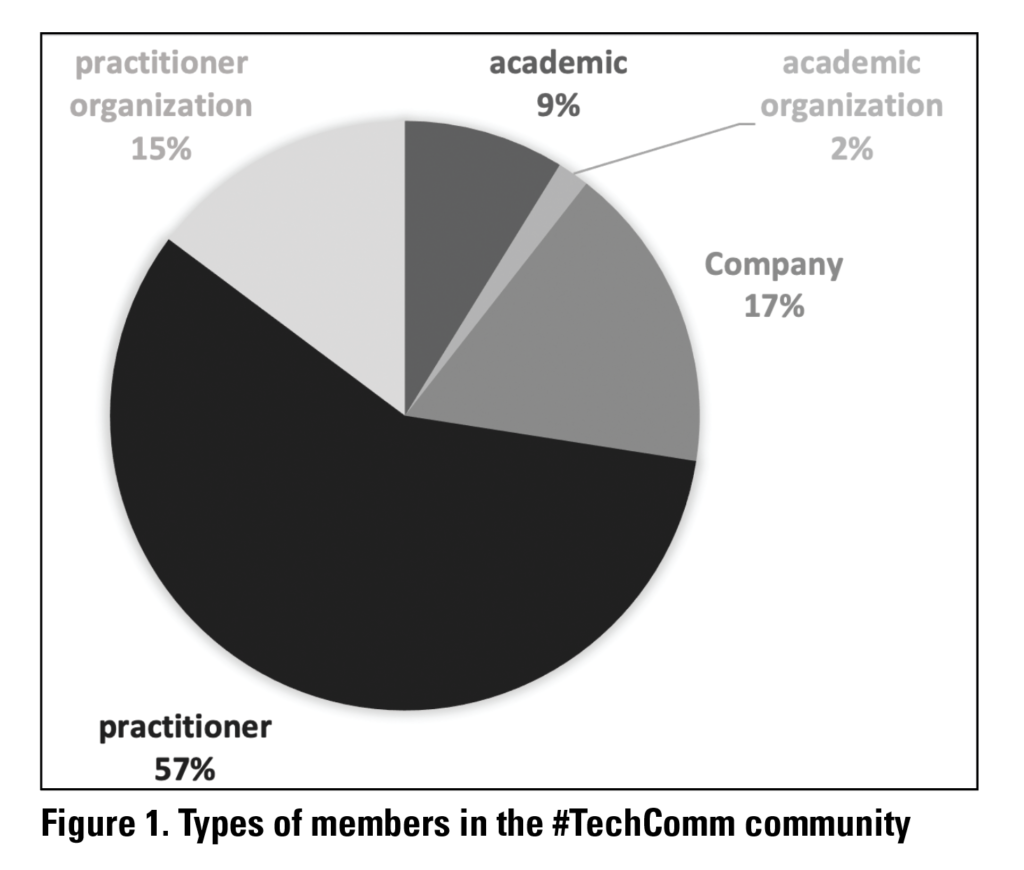 Figure 1. Types of members in the #TechComm community
Figure 1. Types of members in the #TechComm community
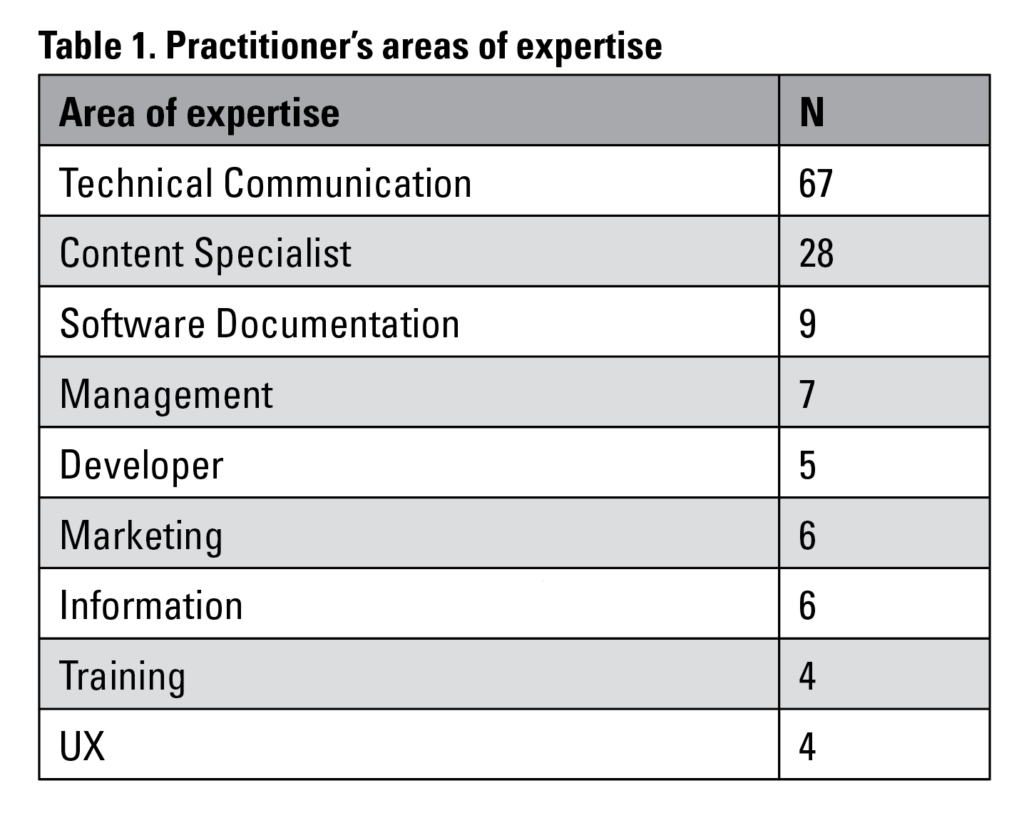 Table 1. Practitioner’s areas of expertise
Table 1. Practitioner’s areas of expertise
The results of an ANOVA comparing the number of Twitter followers by member type revealed no significant differences in reach among the various types of members (F = 1.442, p = 0.221). Across the entire sample, members of the #TechComm community averaged 1733.11 followers. More specifically, practitioner organizations had the highest average followers (M = 3562.5) followed by academic organizations (M = 1535.5), academics (M = 1481.2), practitioners (M = 1429.7), and companies (M = 1232.06). The top practitioners and academics with the largest followings are also summarized in Tables 2 and 3.
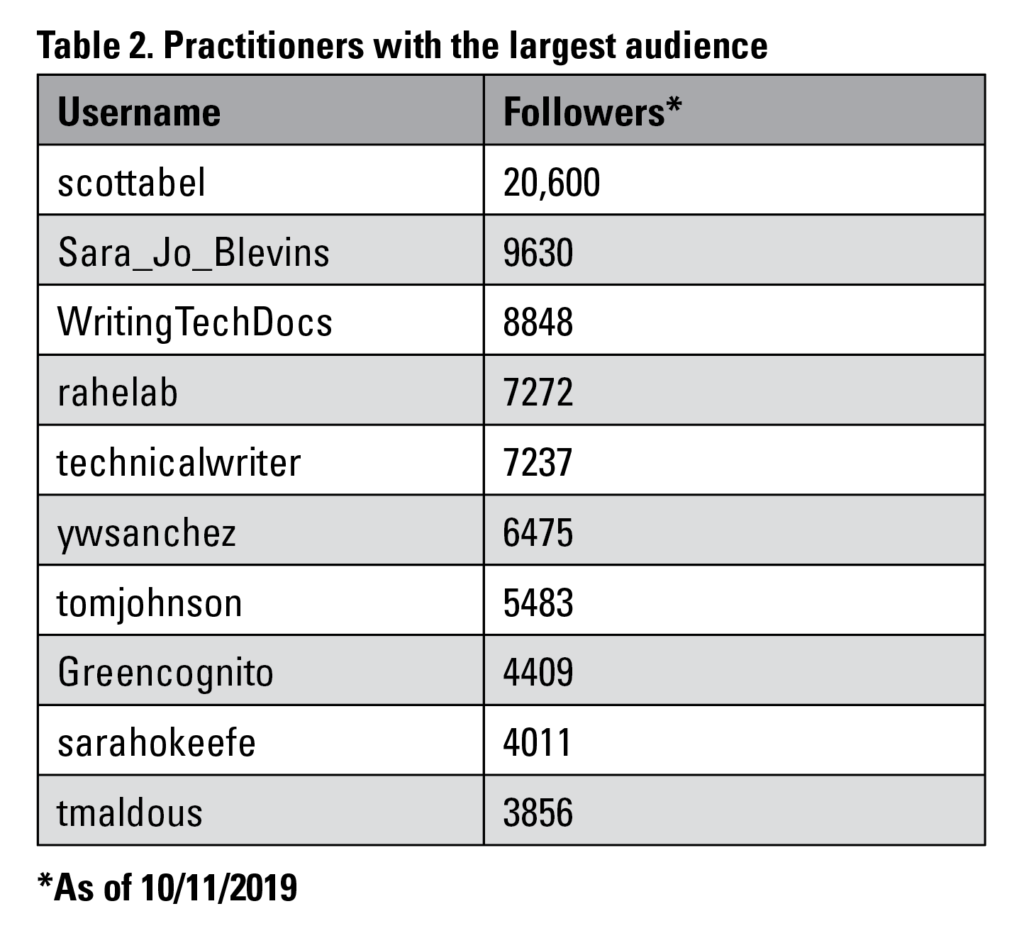 Table 2. Practitioners with the largest audience
Table 2. Practitioners with the largest audience
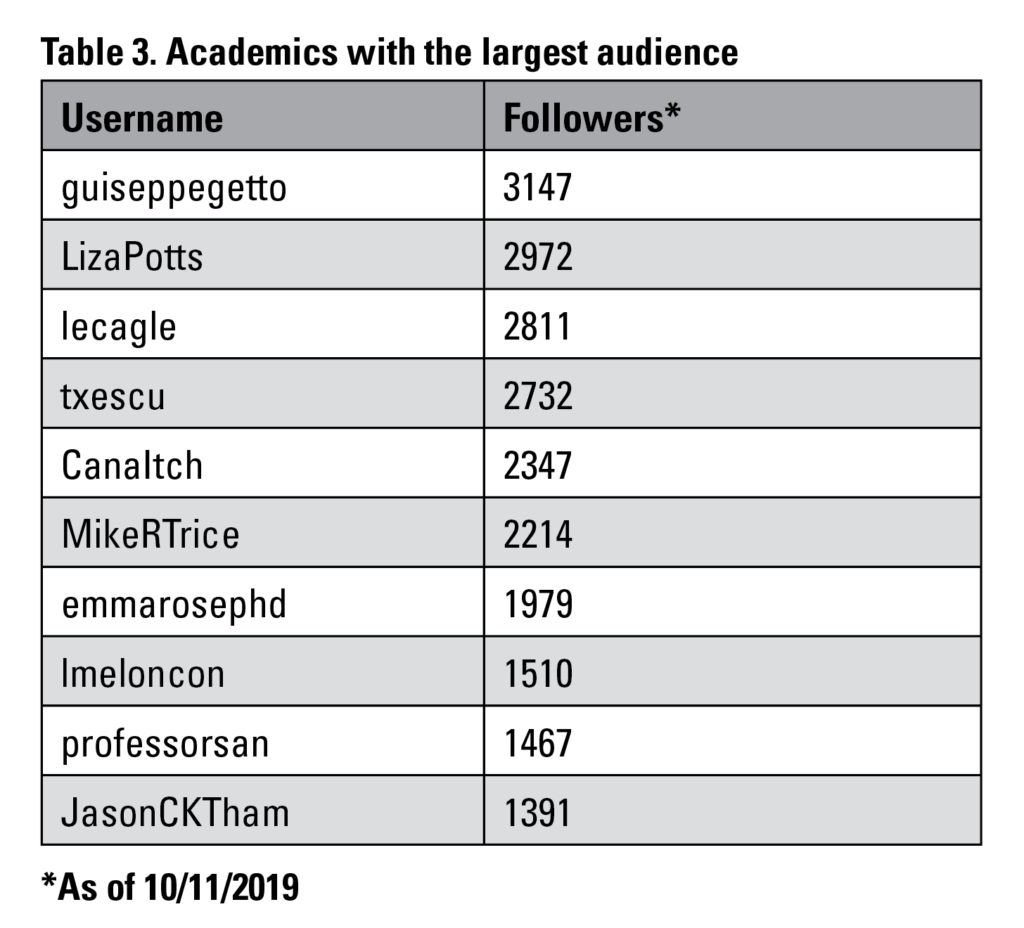 Table 3. Academics with the largest audience
Table 3. Academics with the largest audience
RQ2: What sub-networks exist in the #TechComm community?
Figure 2 shows a visualization of the entire network from 2018-2019 for context. As can be seen in Figure 2, there is a core community within the #TechComm twitterverse. Those users on the outside of these core are only loosely related or involved in the community based on their connection as measured by their mentions, replies, and tweets to other members of the community.
The visualization revealed two primary sub-networks (see Figure 3). The two orbits are centered around two users, which also happen to be the two users with the highest “degree” rating, @lmeloncon (degree rating = 134) and @Flacke (degree rating = 93). Zooming in on each of these networks, while there is some overlap, reveals there are also clear distinctions. For instance, Figure 4 shows that the first network includes mostly academics with little overlap into the networks of practitioners. On the outer orbit is primary academics and most conversations tend to be centered around @lmeloncon, which is the handle of Lisa Meloncon, an academic.
While most of the conversations are centered on @lmeloncon, some side networks and conversations do arise as facilitated through @SDoanUT (36 connections), @docforceO (23 connections), and@tomjohnson (23 connections). @SDoanUT seems to mostly reconnect into the academic orbit, while @docforceO and @tomjohnson both seem to act as a bridge between the two orbits. Tom Johnson is a technical writer and a prominent blogger in the technical communication community.
The second orbit seems to center around the user @Flacke, who, according to the Twitter profile, is in user documentation, topic-based authoring, DITA, and XML. Figure 5 shows a close-up view of this orbit. @flacke is very active on Twitter and mostly retweets other users’ tweets, which then communicates that tweet to her network of almost 1,000 followers.
While @flacke is certainly a main conversationalist in this orbit, there are other conversationalists that other smaller networks form around: @techcommgeekmom, @reb_yoel, @adobe, @adobe_tcs, and @straygoat all are conversationalists within this orbit as well. These users (other than the Adobe handles) are all practitioners and post about a variety of technical communication-related content.
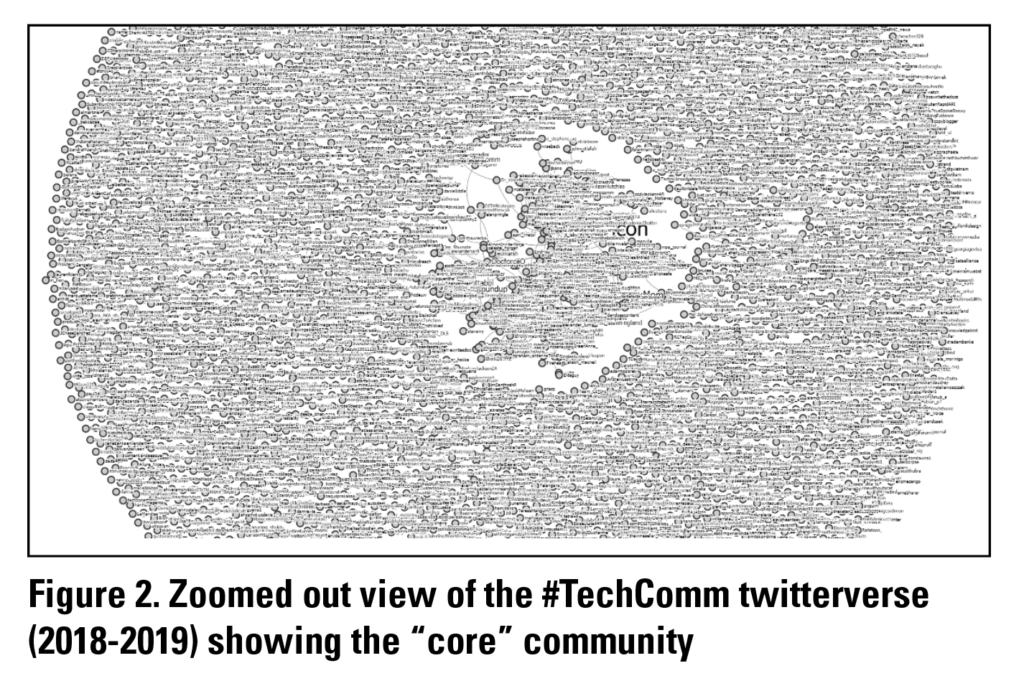 Figure 2. Zoomed out view of the #TechComm twitterverse (2018-2019) showing the “core” community
Figure 2. Zoomed out view of the #TechComm twitterverse (2018-2019) showing the “core” community
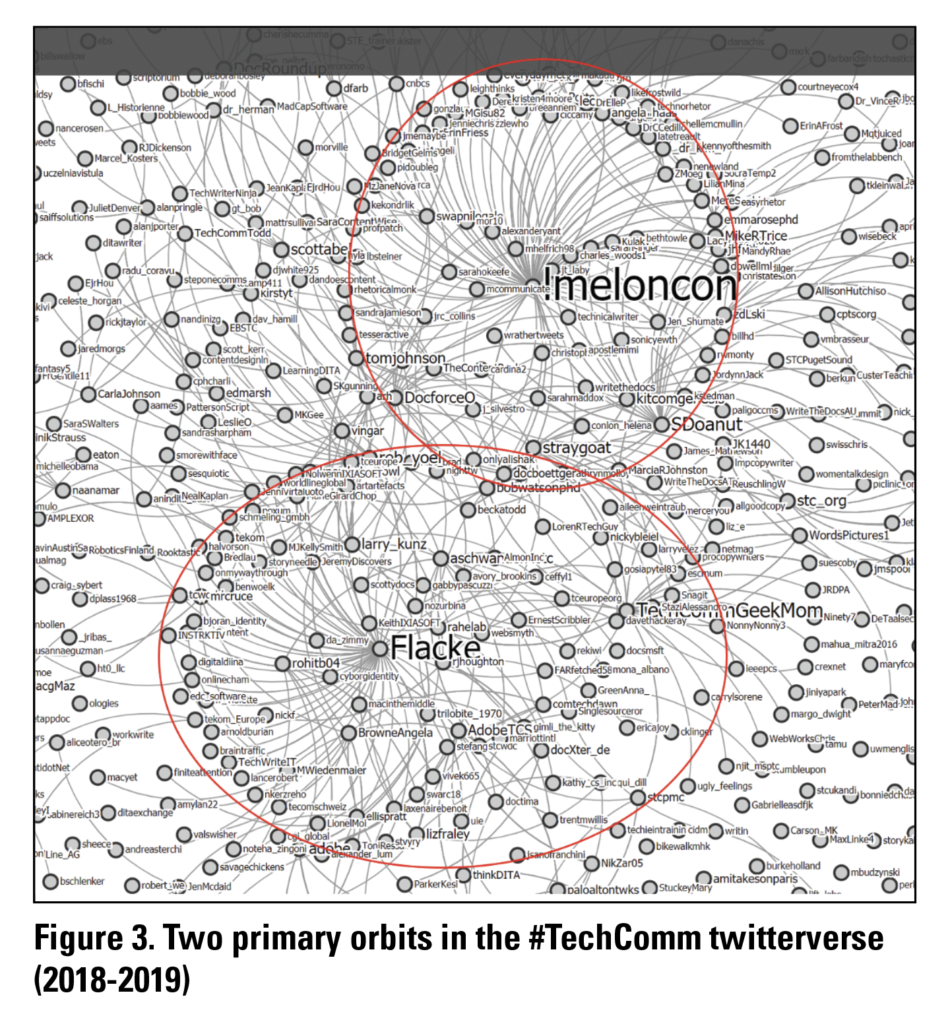 Figure 3. Two primary orbits in the #TechComm twitterverse (2018-2019)
Figure 3. Two primary orbits in the #TechComm twitterverse (2018-2019)
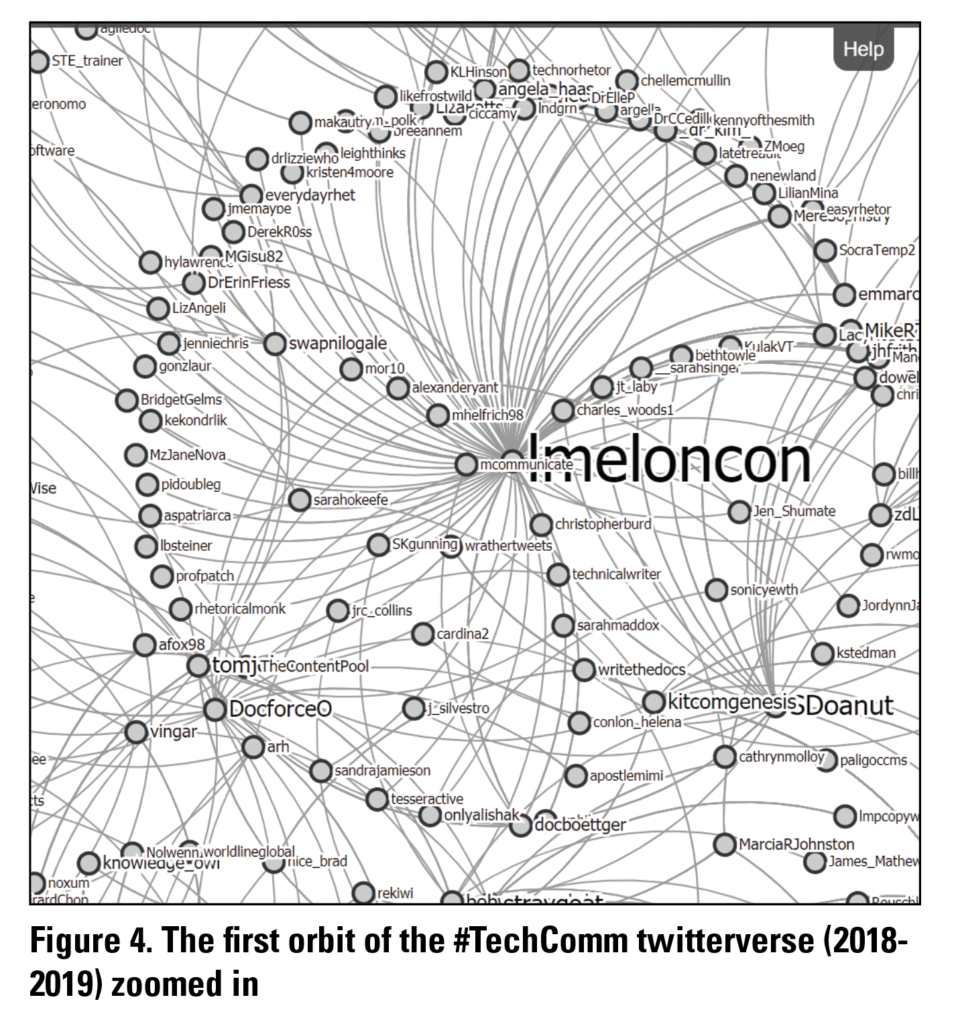 Figure 4. The first orbit of the #TechComm twitterverse (2018-2019) zoomed in
Figure 4. The first orbit of the #TechComm twitterverse (2018-2019) zoomed in
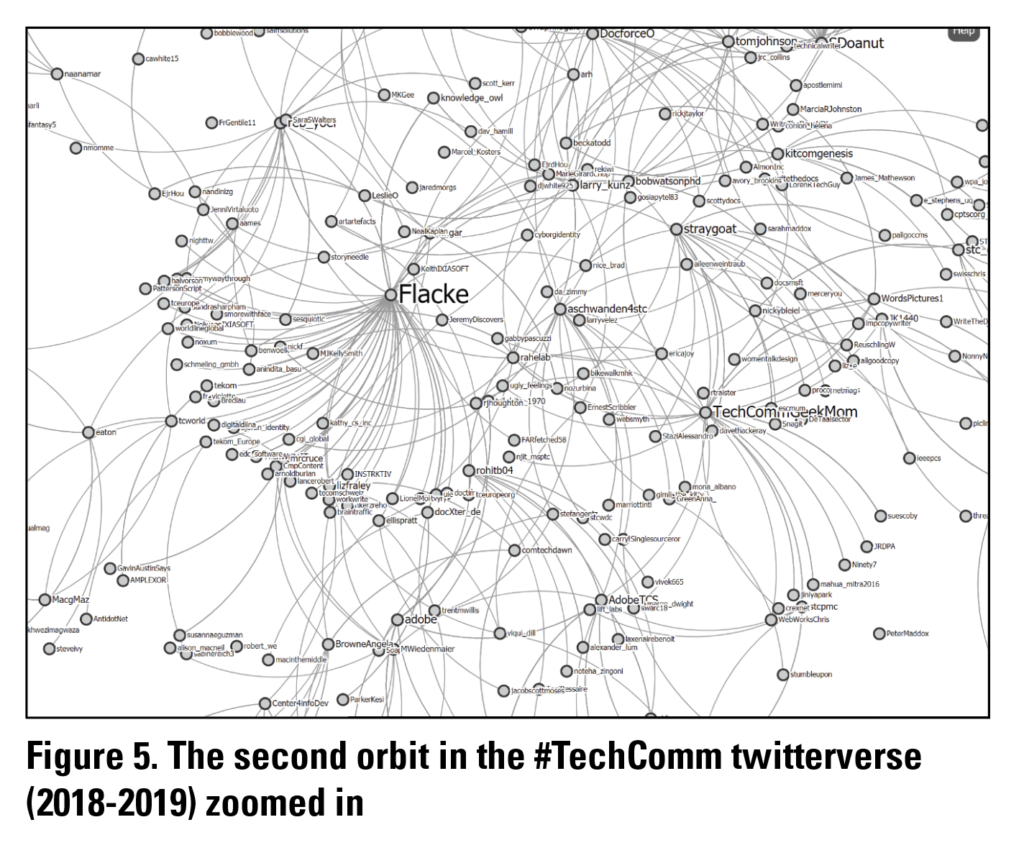 Figure 5. The second orbit in the #TechComm twitterverse (2018-2019) zoomed in
Figure 5. The second orbit in the #TechComm twitterverse (2018-2019) zoomed in
RQ3: What are the major themes that arise in the technical communication twitterverse between 2016 and 2019?
The Kaiser-Meyer-Olkin (KMO) yielded a value of 0.78, which indicates that the data was well-suited for a PCA (Kaiser, 1974). The PCA results indicated that 15 factors extracted resulted in a cumulative 32% of the total variance in the model. Keywords were examined within each factor using AntConc to gain additional context about the word. Based on the 15 extracted factors, there were eight interpretable themes from the PCA.
Theme 1: Adobe TC suite and other authoring tools
The first interpretable theme explained 16% of the total variance of the PCA. Using a cutoff loading value of 0.5, the first factor yielded 60 related keywords. Using AntConc to examine collocates of keywords, the theme centered around Adobe and its tools in the technical communication suite. A summary of significant words, usernames, and hashtags is presented in Table 4 below.
The term HTML5, which occurred 319 times across 44 different Twitter accounts, significantly collocated with the terms Framemaker (n = 46, t = 6.65, p < 0.01) and with the term Robohelp (n = 36, t = 5.93, p < 0.01). So, while HTML5 is a fairly general description of a web markup language, in the context of this corpus, it typically referred to an Adobe tool using that technology. Similarly, the term #contentstrategy, which was by far the most frequently used word in theme 1, significantly co-occurred with the term adobetcs over 1400 times (n = 1401, t = 4.89, p < 0.01). Adobetcs is the official Twitter handle for the Adobe Technical Communication Suite.
Theme 2: STC and the STC Summit
The second interpretable theme explained 10% of the total variance of the PCA. Table 5 summarizes some of the keywords that loaded significantly onto factor 2. Based on an analysis of usernames, hashtags, and words that loaded heavily onto factor 2, the theme of this particular factor is the annual convention of the STC, also referred to as the STC Summit.
The usernames @dr_herman (n = 164) and @viqui_dill (n = 192) are both closely associated with the STC and the STC summit. They both occurred often in the corpus and were mentioned by 38 and 44 different Twitter accounts, respectively.
Theme 3: Academic #TechComm
Theme 3 constituted 8% of the total variance of the PCA. Theme 3’s loadings were very high, and the theme was easy to interpret. Table 6 summarizes the results for significant loadings of usernames, hashtags, and words. While theme 3 generally centers around the academic community, there seems to be a focus on rhetoric as three of the top four hashtags allude to rhetoric.
Theme 4: Professional development and self-improvement
Theme 4 constituted 7% of the total variance of the PCA. Based on the factor loadings, words tended to cluster around the theme of professional development and self-improvement. That is, this theme focused on tweets about how to improve skills or use tools related to technical communication. Table 7 below summarizes the results for theme 4.
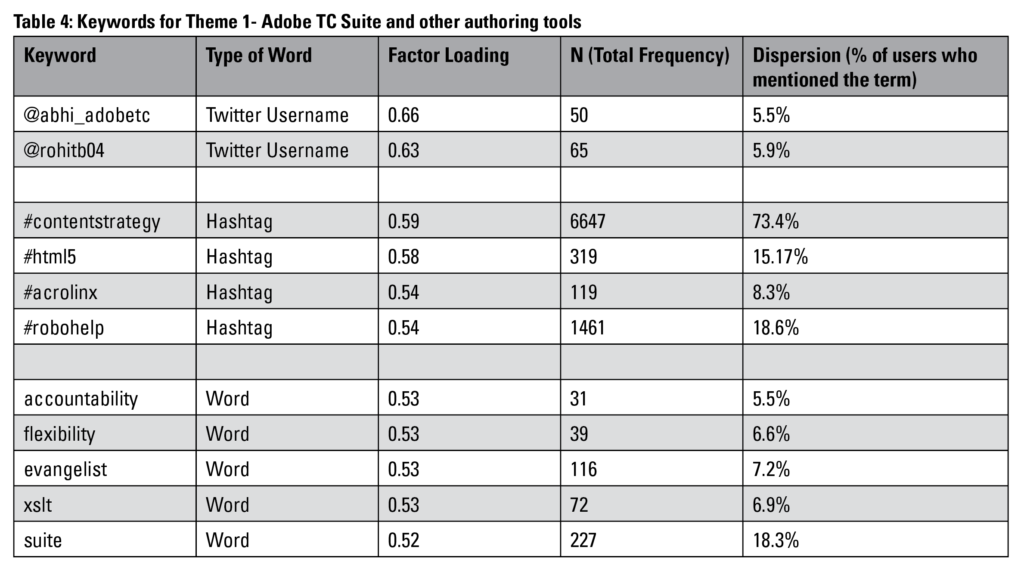
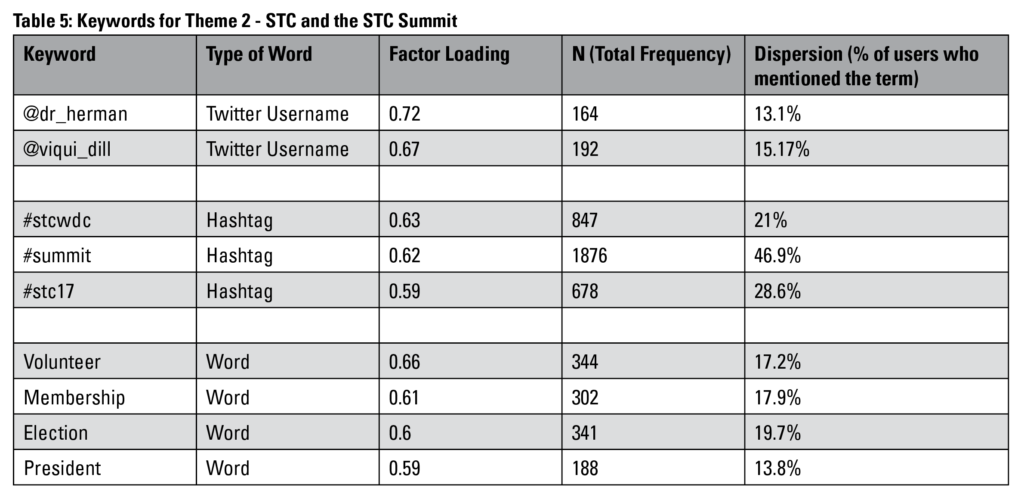
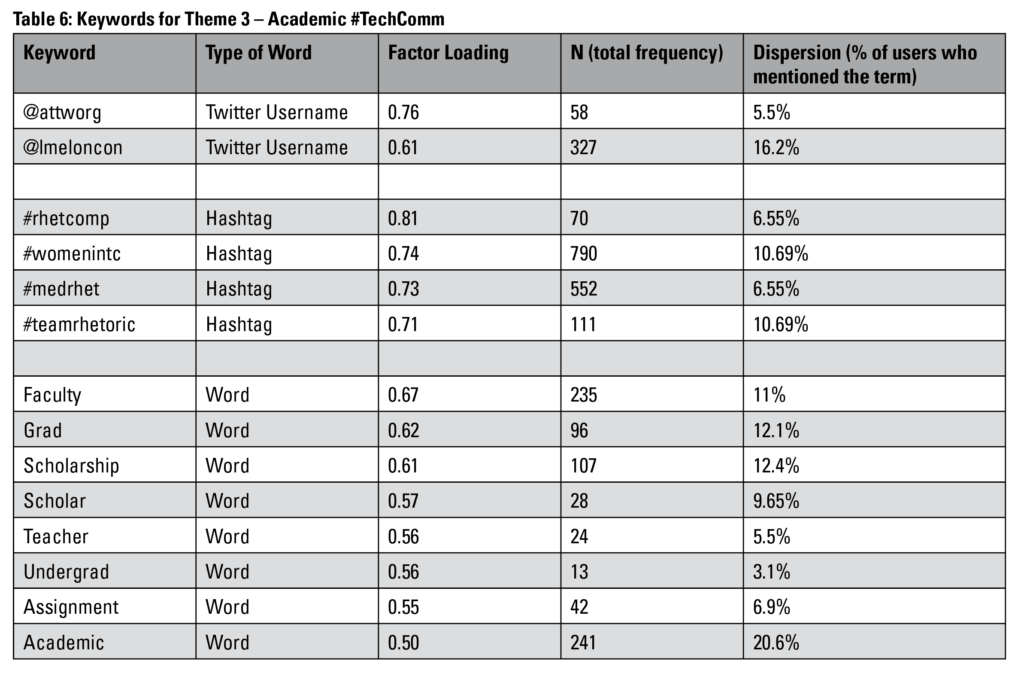 As can be seen in Table 7, much of this theme is dominated by the username and hashtag associated with “clickhelp.” ClickHelp is a company that sells a software documentation tool. As part of their website, they regularly post blog posts about a variety of topics related to technical communication. Many of these articles are about how to improve certain skills and competencies as a technical communicator. Additionally, the terms personality and soft often occurred in the context of tips for improving soft skills and examining the personality of technical writers.
As can be seen in Table 7, much of this theme is dominated by the username and hashtag associated with “clickhelp.” ClickHelp is a company that sells a software documentation tool. As part of their website, they regularly post blog posts about a variety of topics related to technical communication. Many of these articles are about how to improve certain skills and competencies as a technical communicator. Additionally, the terms personality and soft often occurred in the context of tips for improving soft skills and examining the personality of technical writers.
Theme 5: DITA and Lightweight DITA
Theme 5 clusters around the topic of DITA more. Theme 5 accounted for 7% of the total PCA variance. Table 8 (p.16) summarizes some of the most significant factor loadings. A company called Ixiasoft, which is a company that sells an enterprise-class DITA content management system, had a strong presence in this theme. Additionally, the usernames @ditawriter and @nkerzreho are both associated with the company as well. In addition to these, @scriptorium is the account for a content strategy consultancy that provides DITA-related deliverables as well.
Hashtags for Theme 5 are also clearly centered around DITA as well, including the #lwdita hashtag that stands for lightweight DITA. I conducted a collocate analysis of the top two hashtags (#ditaxml and #lwdita) to determine what other words were significantly associated with these hashtags. For #ditaxml, words like contentstrategy (n = 156, t = 5.26, p < 0.01), learn (n =38, t = 38, p < 0.01), and register (n = 49, t = 5.16, p < 0.01) all significantly co-occurred with #ditaxml. Interestingly, for the hashtag #lwdita, words like techie (n = 6, t = 14.9, p < 0.01), carlos (n = 6, t = 12.8, p < 0.01), evia (n = 6, t = 13.1, p < 0.01), and academic (n = 6, t = 9.59, p < 0.01) all significantly co-occurred with #lwdita. These occurrences indicate that the topic of lightweight DITA is one that has some academic crossover, particularly by Carlos Evia, a professor at Virginia Tech University who has published extensively on DITA (Evia & Priestley, 2016). Finally, it seems as though DITA has international relevance with both U.S. and international conferences devoted to discussing varying aspects of DITA.
Theme 6: Job opportunities in technical communication
Theme 6, which accounted for 7% of the total variance of the PCA, centered around jobs in #TechComm. In this theme, no usernames or hashtags loaded significantly onto the factor. However, the words that did load were all clearly job related, as can be seen in Table 9. Based on the data, it appears many job postings are located in New York and Texas. Additionally, the term “analyst” appears often across the sample.
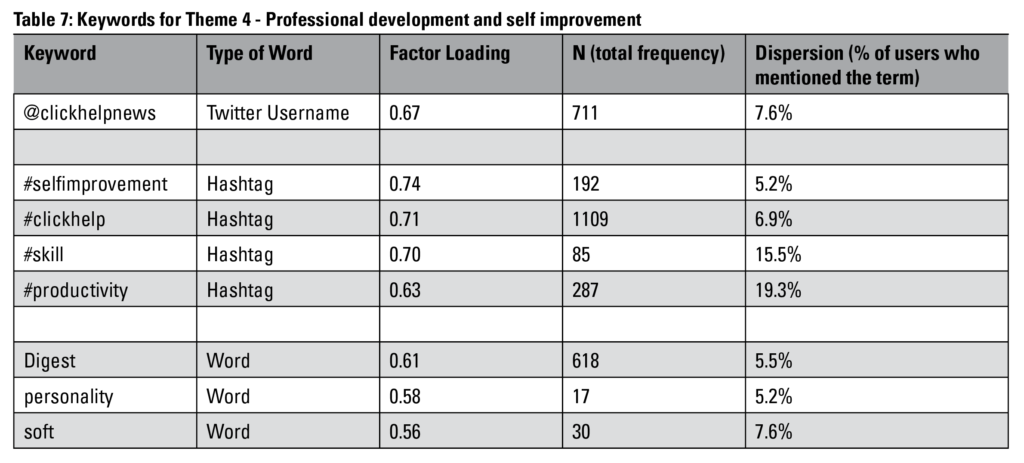
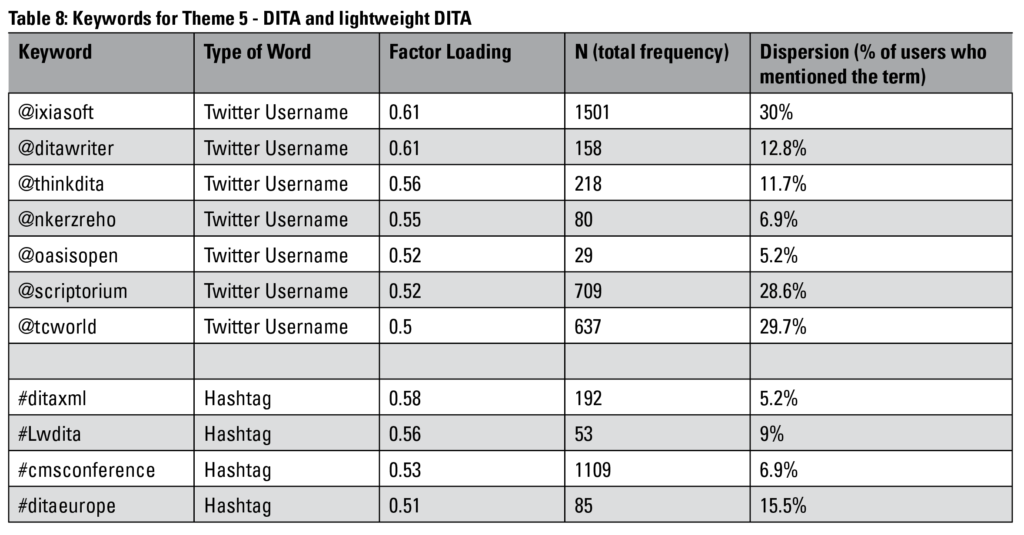
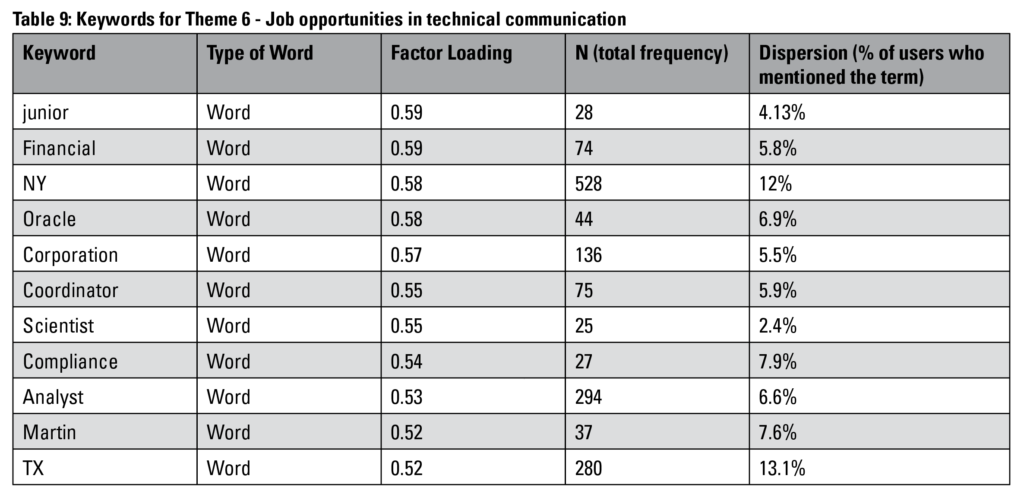
Theme 7: Software documentation and Write the Docs
The final interpretable theme was around software documentation, and specifically the organization. Write the Docs, which focuses on software documentation. Table 10 summarizes the results. The main usernames that load onto this theme significantly are all practitioners, and @ericholscher is a co-founder of the Write the Docs organization. Additionally,
@chrischinch significantly co-occurs with the term writethedocs (n = 17, t = 7.63, p < 0.01). The hashtag #wtd refers to the Write the Docs organization. Finally, Sphinx is a technical documentation tool used for software documentation. Sydney occurred about the Write the Docs Australia conference.
DISCUSSION
The findings from this analysis of the #TechComm community provide a variety of insights that will be helpful for both practitioners and academics. In the following section, I discuss three important takeaways in more detail.
Sub-communities in the #TechComm Serve Different Audiences and Purposes
While not totally surprising, a major finding of this analysis of the #TechComm community revealed a few key sub-communities. Based on the network analysis visualizations, there appeared to be two major orbits within the #TechComm community: academics and practitioners. There also seemed to be only limited overlap between the two communities. This confirms prior research that has pointed to a divide between practitioners and academics. For instance, a 2016 article examining the content of formal content forums for technical communicators (academic journals and magazines) suggested that there was very little content overlap between forums for academics and practitioners (Boettger & Friess, 2016). While that study examined formal publication venues, it seems that content discussed on Twitter also has little overlap. This is not surprising given the varying interests and motivating factors for both practitioners and academics. It also seems further exacerbated by the fact that the academic community centered around a few key users who often focused on content only relevant to academics like #MentorMonday, which tends to focus on mentoring within the context and demands of academic life. It is also important to note that the findings of the study are indeed limited to users who used the hashtag #techomm, so there certainly could have been more interaction and overlap between audiences without the hashtag.
The themes from research question three provide some helpful insight into some of the important conversations and topics within the #TechComm community. Within the practitioner orbit, there seemed to be a focus on documentation and the tools and technologies related to software documentation. Based on the network visualizations, one of the main conversationalists was @flacke, who identified as a documentation specialist. Further, the themes that arose in research question three further reveal that the community had focused conversations on the tools (Adobe TC Suite in theme 1), technologies (DITA and XML in theme 5), and conferences (STC and Write the Docs in Theme 2 and Theme 7, respectively) that help technical communicators in their work. Overall, it seems that practitioners have a vibrant community and consistently use the hashtag #TechComm to share important aspects of their work.
#TechComm Provides an Opportunity for Bridging the Practitioner-Academic Divide
While there are some distinctions between the two major orbits within #TechComm, there are distinct opportunities for bridging the practitioner-academic divide. There are, at least, two ways in which academics might leverage the findings of this study. First, for those involved in ensuring curriculum is meeting the needs of industry, this study bears some weight on the question of whether programs should be teaching tools, and if so, which tools to teach. Based on the variety of tools mentioned in the tweets, there does not appear to be an “industry standard” authoring tool. For instance, Adobe TC Suite, ArborText, Sphinx, IXIASOFT, and Oasis all loaded significantly on a variety of themes. What is foundational across the tools, however, are the technologies they are built upon, including XML and DITA. That is, programs might consider a course teaching these foundational technologies and exploring how knowledge of the technology impacts the successful use of a variety of tools. Furthermore, as students learn foundational technologies, they must then also learn about foundational concepts of topic-based authoring, single sourcing, and content reuse. Although the study is six years old, Meloncon and Henschel’s comprehensive survey of undergraduate programs specifically noted a lack of XML and DITA instruction across undergraduate programs (Meloncon & Henschel, 2013). While some programs may already implement such courses, it seems that undergraduate programs would be missing out on a major component of technical communication without at least one course dedicated to authoring using XML and/or DITA.
Aside from considering curricular changes, academics can use the results of this study to better understand practitioners’ needs and potentially meet needs while forming new research questions. Tom Johnson, a technical communicator, has been exploring divides between practitioners and academics for over a decade. Based on the network visualizations in Figure 3, Tom was also one of the few members of #TechComm that straddled between the two major orbits. His tweet in 2018 is a great summary of the divide:
“If the words ‘rhetoric’ and ‘rhetorical’ were off-limits to #techcomm academics, the word count in their articles would drop at least 20%.” (Johnson, 2018)
While his observation was humorous, he makes a good point and one that extends beyond just academic articles that he references in the tweet. In fact, results of the study revealed that the academic theme included three hashtags with rhetoric in them. Further, the word “rhetoric” appeared 111 times in the sample and was tweeted almost exclusively by academics. While there is nothing wrong with theoretically grounding research using rhetorical frameworks, academics might take this perspective into mind when engaging in #TechComm.
As part of Tom’s effort to bridge the practitioner/academic divide, he conducted a survey in 2018 and found that a large percentage of academics admitted they do not understand the issues practitioners face in the workplace. One way to begin remedying this (along with joining the tc-academic-practitioner-bridge email list and reading Tom’s blog) is by simply engaging in #TechComm outside of the academic orbit. Based on the results of this study, we know that practitioners already share workplace experiences and issues on Twitter. But, beyond that, practitioners are willing and able to directly answer questions. By directly mentioning specific users from the practitioner community, perhaps academics can use #TechComm as a sounding board for a research idea to gain feedback about how to approach a research study as they might at a more formal conference presentation where the audience is primarily academics.
Additional Takeaways for Practitioners of Technical Communication
The findings of this study revealed a vibrant community of technical communicators on Twitter using the hashtag #TechComm with most community members being practitioners. One key finding was the prominence of the hashtag #ditaxml. One practical takeaway for practitioners from this finding is that DITA and XML remain prominent in the #TechComm community. While this may not seem like a revelation, there has been much debate over the staying power of DITA (and perhaps even more so, the staying power of XML), with some who believe that DITA may no longer be relevant for technical communicators (Gillepsie, 2019; Johnson, 2015). Interestingly, another prominent hashtag was the hashtag #lwdita, which stands for lightweight DITA. Developed by Carlos Evia, Michael Priestley, and a committee of volunteers, lightweight DITA is an architecture that does not rely on any particular technology or language, including XML (Evia & Priestley, 2016). Therefore, regardless of where you fall on the DITA debate, the prominence of DITA, XML, and lightweight DITA in this study points to an underlying trend of the importance of structured and topic-based authoring. While this manifested as DITA and XML in this study, it would be interesting to see if the technology shifts to something new in a future study. Regardless, participating in the #TechComm community will help provide practitioners with these answers in the future.
Results from this study can also be used as evidence for practitioners seeking professional development opportunities in their respective workplaces. For instance, much of the content related to DITA included announcements for “bootcamps” and other workshops dedicated to teaching the architecture. The presence of these workshops indicates that there is a need for additional professional development to learn DITA. Therefore, for practitioners who have yet to learn DITA, results from this study can be used to support requests for funding from decision decision-makers. For those practitioners who already are using DITA, results from the study could be used as evidence for upgrading or updating organizational workflows to include a content management system that integrates DITA or some other topic-based approach.
The study also revealed which sub-disciplines or sub-fields were most prevalent in sharing the hashtag #TechComm—namely #contentstrategy. While it is no surprise that technical communication and content strategy are related, the study revealed some context around the relationship between content strategy and technical communication. That is, one finding indicated that content strategy significantly occurred alongside the hashtag #ditaxml. The association of #ditaxml and #contentstrategy is significant because content strategy has become a catch-all term and can mean many different things to different people. For some, content strategy involves strategically considering content themes, messages, topics, and purpose. For others, the emphasis is on content metadata frameworks and content reuse (Halvorson, 2008). Based on the results of this study, it seems that for technical communicators content strategy is much more closely aligned to content reuse and metadata frameworks. While this certainly has implications for educators in how they should be approaching and teaching content strategy, it also has implications for practitioners looking to pivot their work into the world of content strategy as well.
Finally, in addition to trends surrounding DITA and related technologies, the study revealed the prevalence of events and organizations. Common themes arose around organizations (STC, Write the Docs) and events (STC Summit, Write the Docs). Joining these societies and attending these events can be quite expensive, however. For example, it can cost up to U.S. $1,800 to attend the STC Summit. So, for technical communicators who are not formal members of societies or regular attendees at annual events, this study is a good starting point for examining the relative value of joining an organization. Additionally, the results of this study could be used as evidence when asking for funding to attend these events or memberships to relevant societies.
LIMITATIONS AND DIRECTIONS FOR FUTURE RESEARCH
With any empirical study, there are limitations. First, this study provided only a high-level overview of the hashtag #TechComm. It provided a snapshot of the major topics discussed in the community and an overview of who comprises the community. It did not, however, examine the content of individual tweets within the community. A future study could sample the #TechComm tweets and conduct a content analysis to further explore the topics with a greater level of specificity. Additionally, there are two limitations related to the Twitter data sample itself. First, research has pointed to the propensity for Twitter’s API to have biases for collecting data, which could lead to an incomplete dataset (González-Bailón, Wang, Rivero, Borge-Holthoefer, & Moreno, 2014). While the study (González-Bailón, Wang, Rivero, Borge-Holthoefer, & Moreno, 2014) involved much larger datasets than the one in this study, the potential for both missed users and underrepresented connections is still a valid limitation to point out. Also related to the dataset, another limitation of the study is the self-selecting nature of the sample used in the analysis. That is, the hashtag #TechComm only comprises those who voluntarily are on Twitter and then subsequently use the hashtag #TechComm. There are certainly many technical communicators who are not represented in this sample, so the conclusions cannot be generalized across the entire field. Future studies could utilize a different sampling method and research method, survey or interview for example, to further test the validity of these findings.
This study provided a descriptive overview of the #TechComm community from 2016-2019 by describing the members of the community, the sub-networks that exist in the community, and the major topics of conversation within the community. While limited in scope, it has created an important historical record of what has happened in the field. The hashtag #TechComm continues to be widely used, and this study provides a basis for comparison in future studies of this robust and everchanging community.
REFERENCES
Albers, M. J. (2005). The future of technical communication: Introduction to This Special Issue. Technical Communication, 52(3) 267–272.
Boettger, R. K., & Friess, E. (2016). Academics are from mars, practitioners are from venus: Analyzing content alignment within technical communication forums. Technical Communication, 63(4), 314–327.
Boettger, R. K., & Palmer, L. A. (2010). Quantitative content analysis: Its use in technical communication. IEEE Transactions on Professional Communication, 53(4), 346–357. https://doi.org/10.1109/TPC.2010.2077450
Boyd, D., Golder, S., & Lotan, G. (2010). Tweet, tweet, retweet: Conversational aspects of retweeting on twitter. Proceedings of the Annual Hawaii International Conference on System Sciences, Honolulu, HI, USA, 2010, pp. 1–10. https://doi.org/10.1109/HICSS.2010.412
Boyd, R. L. (2017). Data Analytics in Digital Humanities. Data Analytics in Digital Humanities, (May). https://doi.org/10.1007/978-3-319-54499-1
Brumberger, E., & Lauer, C. (2015). The evolution of technical communication: An analysis of industry job postings. Technical Communication, 62(4), 224–243. Retrieved from http://www.ingentaconnect.com/content/stc/tc/2015/00000062/00000004/art00002
Clark, D., & Andersen, R. (2005). Renegotiating with technology: Training towards more sustainable technical communication. Technical Communication, 52(3), 289–301.
Dubinsky, J. M. (2015). Products and processes: Transition from “product documentation to… integrated technical content.” Technical Communication, 62(2), 118–134.
Evia, C., & Priestley, M. (2016). Structured authoring without XML: Evaluating lightweight DITA for technical documentation. Technical Communication, 63(1), 23–37.
Fisher, L., & Bennion, L. (2005). Organizational implications of the future development of technical communication: Fostering communities of practice in the workplace. Technical Communication, 52(3), 277–288.
Friess, E., & Lam, C. (2018). Cultivating a sense of belonging: Using twitter to establish a community in an introductory technical communication classroom. Technical Communication Quarterly, 27(4), 343–361.
Gillepsie, R. (2019). DITA is dead! LinkedIn. https://www.linkedin.com/pulse/dita-dead-rob-gillespie/
González-Bailón, S., Wang, N., Rivero, A., Borge-Holthoefer, J., & Moreno, Y. (2014). Assessing the bias in samples of large online networks. Social Networks, 38(1), 16–27. https://doi.org/10.1016/j.socnet.2014.01.004
Graham, R., & Smith, S. (2016). The content of our # characters : Black twitter as counterpublic. Sociology of Race and Ethnicity, 2(4), 433–449. https://doi.org/10.1177/2332649216639067
Hackos, J. T. (2005). The future of the technical communication profession: The perspective of a management consultant. Technical Communication, 52(3), 275–276.
Halvorson, K., Wagner, J., Gilbert, R., Nugent, L., Patterson, M. E., Carter, D., & Martinez, C. (2008, December 17). The discipline of content strategy. Retrieved March 22, 2021, from Alistapart.com website: https://alistapart.com/article/thedisciplineofcontentstrategy/
Henning, T., & Bemer, A. (2016). Reconsidering power and legitimacy in technical communication: A case for enlarging the definition of technical communicator. Journal of Technical Writing and Communication, 46(3), 311–341. https://doi.org/10.1177/0047281616639484
Hermida, A., & Lewis, S. C. (2014). Sourcing the Arab Spring : A case study of Andy Carvin’s sources on Twitter during the Tunisian and Egyptian revolutions. Journal of Computer-Mediated Communication. 19(3), 479–499. https://doi.org/10.1111/jcc4.12074
Johnson, T. (2015). 10 reasons for moving away from DITA. I’d Rather Be Writing. https://idratherbewriting.com/2015/01/28/10-reasons-for-moving-away-from-dita/ Tom Johnson[@tomjohnson]. (2018, July 15). If the words “rhetoric” and “rhetorical” were off-limits to #techcomm academics, the word count in their articles would drop by at least 20%. Twitter. https://twitter.com/tomjohnson/status/1018635399718055936
Kaiser, H. F. (1974). An index of factorial simplicity. Psychometrika, 39(1), 31–36. https://doi.org/10.1007/BF02291575
Kimball, M. A. (2015). Training and education: Technical communication managers speak out. Technical Communication, 62(2), 135–145.
Lam, C., & Hannah, M. A. (2017). The social help desk. Communication Design Quarterly Review, 4(2), 37–51. https://doi.org/10.1145/3068698.3068702
Lam, C., Hannah, M. A., & Friess, E. (2016). Connecting programmatic research with social media: Using data from Twitter to inform programmatic decisions. Programmatic Perspectives, 8(2), 47–71.
McKee, H., & Porter, J. E. (2008). The ethics of digital writing research: A rhetorical approach. College Composition and Communication, 59(4), 711–749.
Meloncon, L., & Henschel, S. (2013). Current state of U.S. undergraduate degree programs in technical and professional communication. Technical Communication, 60(1), 45–64.
Potts, L. (2013). Social media in disaster response: How experience architects can build for participation. Routledge.
Potts, L., Seitzinger, J., Jones, D., & Harrison, A. (2011). Tweeting disaster: Hashtag constructions and collisions. SIGDOC’11 – Proceedings of the 29th ACM International Conference on Design of Communication, 235–240. https://doi.org/10.1145/2038476.2038522
Rainey, K. T., Turner, R. K., & Dayton, D. (2005). Do curricula correspond to managerial expectations ? Core competencies for technical communicators. Technical Communication, 52(3), 323–352.
Redish, J. (2003). Adding value as a professional technical communicator. Technical Communication, 50(4), 505–518.
Rice-Bailey, T. (2016). The role and value of technical communicators: Technical communicators and subject matter experts weigh in. Technical Communication Quarterly, 25(4), 230–243. https://doi.org/10.1080/10572252.2016.1221140
Stanton, B. R. (2017). Do technical/professional writing (TPW) programs offer what students need for their start in the workplace ? A comparison of requirements in program curricula and job ads in industry. Technical Communication, 64(3), 223–236.
Stephansen, H. C., & Couldry, N. (2014). Understanding micro-processes of community building and mutual learning on twitter: A ‘small data’ approach. HICSS-43. IEEE, 17(10), 1212–1227. https://doi.org/10.1080/1369118X.2014.902984
Whiteside, A. L. (2003). The skills that technical communicators need: An investigation of technical communication graduates, managers, and curricula. Journal of Technical Writing & Communication, 33(4), 303–318. https://doi.org/10.2190/3164-E4V0-BF7D-TDVA
ABOUT THE AUTHOR
Chris Lam received a PhD in Technical Communication and MS in Information Design from the Illinois Institute of Technology. He is an associate professor in the Department of Technical Communication at the University of North Texas. He studies communication in team projects, examines the literature on professional and technical communication and its impact on the profession, and applies data from social media to practical and pedagogical issues in technical and professional communication. He has also developed a platform (CrowdsourceTPC.com) that aims to provide open source resources to technical communication practitioners, instructors, and academics. He is available at chris.lam@unt.edu.
Manuscript received 6 November 2019, revised 10 February 2020; accepted 5 June 2020.

